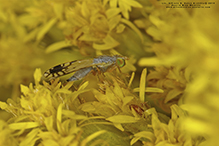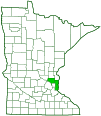fruit fly
(Trupanea actinobola)
Conservation • Description • Habitat • Biology • Distribution • Taxonomy
Conservation Status |
|
|||||||
| IUCN Red List | not listed |
|||||||
| NatureServe | NNR - Unranked |
|||||||
| Minnesota | not listed |
|||||||
Description |
||
Trupanea actinobola is a small fruit fly. It occurs across the United States and southern Canada. It is most common in the southwest, fairly common in Minnesota. Adults are found on the flower heads of several genera, including Aster, Coreopsis, Erigeron, Gnaphalium, Hieracium, Solidago, and Symphyotrichum. The head is yellowish-gray, about as long as high, and relatively flat when viewed from the side. There are two large compound eyes on the sides of the head and three small simple eyes (ocelli) in a triangle on top of the head. The compound eyes are green and bare, with no hairs. They do not meet at the top of the head on either sex. There are five bristles near the inner margin of each compound eye, two upper (orbital) bristles and three lower (frontal) bristles. The thorax is gray and has three segments. Each segment has four principal exoskeletal plates, one above, one below, and one on each side. The upper (dorsal) plates, from front to rear, are the prescutum, scutum, and scutellum. The scutum has several long, black bristles, each rising from a small but distinct black spot, and numerous shorter hairs. There are two longitudinal rows of bristles on each side of the scutum near the middle. The outer (dorsocentral) row has just a single bristle. There is also a row of bristles (supra-alar bristles) near each lateral margin. There is a convex swelling (humeral callus) on the front corners of the scutum, and a pair of bristles on each humeral callus. The scutellum has a single pair of bristles and a fringe of shorter hairs. The abdomen is gray. At the tip of the abdomen the ovipositor on the female and the external genitalia on the male are black. The wings are clear at the base and have a pattern on the outer third. The pattern is a large dark spot on the leading edge (costal margin) with rays radiating to the inner and costal margins. Within the dark spot there is a small clear spot near the costal margin. The wing pattern is diagnostic to the species. The legs are yellow. |
||
Size |
||
|
||
Similar Species |
||
Habitat |
||
Fields |
||
Biology |
||
Season |
||
Mid-May through October (CCESR) |
||
Behavior |
||
|
||
Life Cycle |
||
The female deposits eggs on the flower heads of host plants. The larvae enter and feed on the ovaries. |
||
Larva Food |
||
|
||
Adult Food |
||
Several genera of plants, including Aster, Coreopsis, Erigeron, Gnaphalium, Hieracium, Solidago, and Symphyotrichum. |
||
Distribution |
||||
|
Sources Handbook of the Fruit Flies (Diptera: Tephritidae) of America North of Mexico. Richard H. Foote, P. L. Blanc, Allen L. Norrbom. 1993. Cornell University Press (Comstock Publishing). |
|||
| 1/31/2021 | ||||
Occurrence |
||||
Fairly common in Minnesota |
||||
Taxonomy |
|||
Order |
Diptera (flies) | ||
Suborder |
Brachycera | ||
Infraorder |
Muscomorpha | ||
| No Rank | Eremoneura | ||
| No Rank | Cyclorrhapha | ||
| Zoosection | Schizophora (schizophora flies) | ||
| Zoosubsection | Acalyptratae (acalyptrate flies) | ||
Superfamily |
Tephritoidea (fruit, signal, and picture-winged flies) | ||
Family |
Tephritidae (fruit flies) | ||
Subfamily |
Tephritinae | ||
Tribe |
Tephritini | ||
| No Rank | Tephritis genus group | ||
Genus |
Trupanea | ||
Synonyms |
|||
Trypeta actinobola |
|||
Common Names |
|||
This species has no common name. The common name for the family Tephritidae is fruit flies, and it is applied here for convenience. |
|||
Glossary
Costal margin
The leading edge of the forewing of insects
Ocellus
Simple eye; an eye with a single lens. Plural: ocelli.
Scutellum
The exoskeletal plate covering the rearward (posterior) part of the middle segment of the thorax in some insects. In Coleoptera, Hemiptera, and Homoptera, the dorsal, often triangular plate behind the pronotum and between the bases of the front wings. In Diptera, the exoskeletal plate between the abdomen and the thorax.
Scutum
The forward (anterior) portion of the middle segment of the thorax (mesonotum) in insects and some arachnids.
Visitor Photos |
|||||
Share your photo of this insect. |
|||||
| This button not working for you? Simply email us at info@MinnesotaSeasons.com. Attach one or more photos and, if you like, a caption. |
|||||
Alfredo Colon |
|||||
 |
|||||
MinnesotaSeasons.com Photos |
|||||
|
|||||

Slideshows |
||

Visitor Videos |
|||
Share your video of this insect. |
|||
| This button not working for you? Simply email us at info@MinnesotaSeasons.com. Attach a video, a YouTube link, or a cloud storage link. |
|||
Other Videos |
|||

Created: 1/31/2021
Last Updated:


